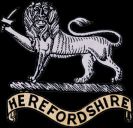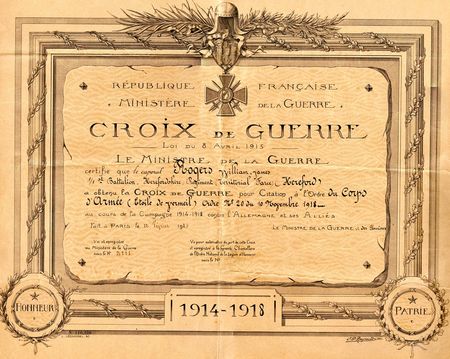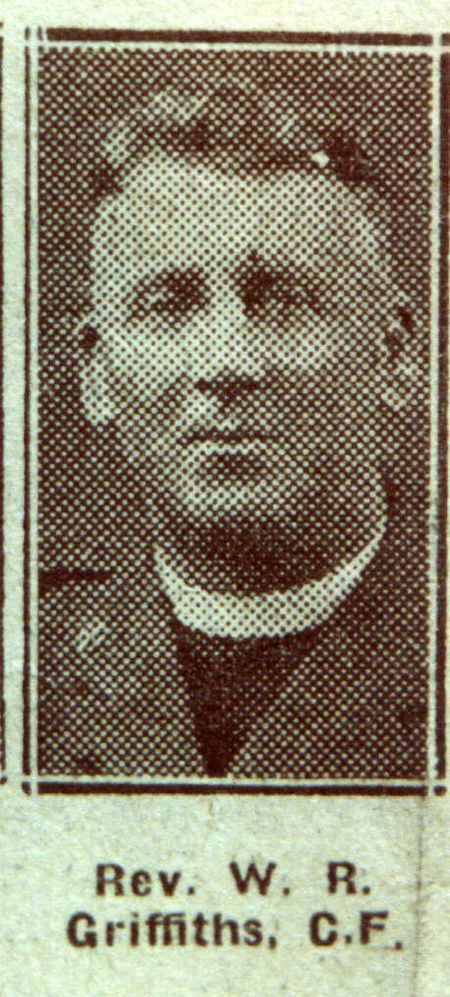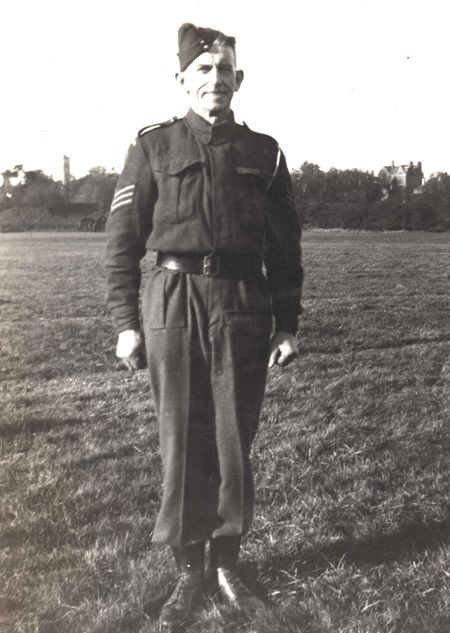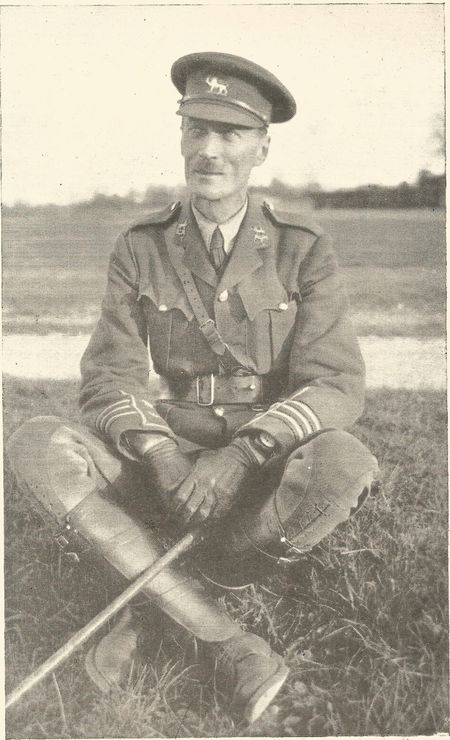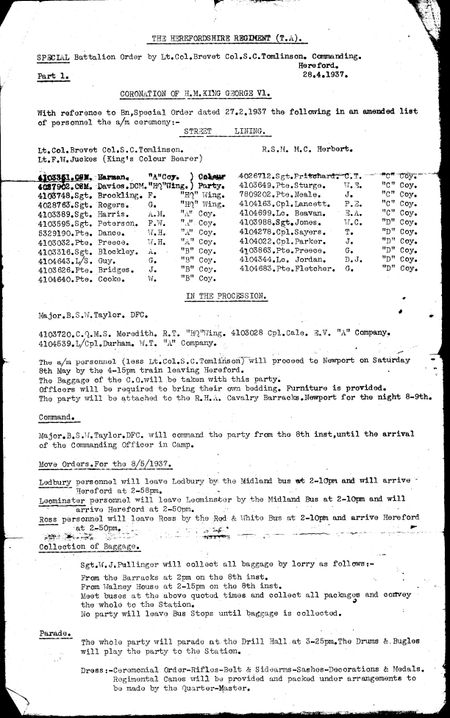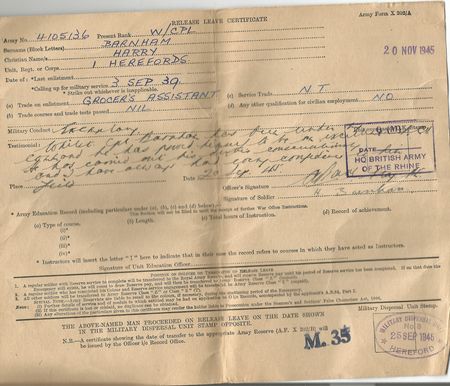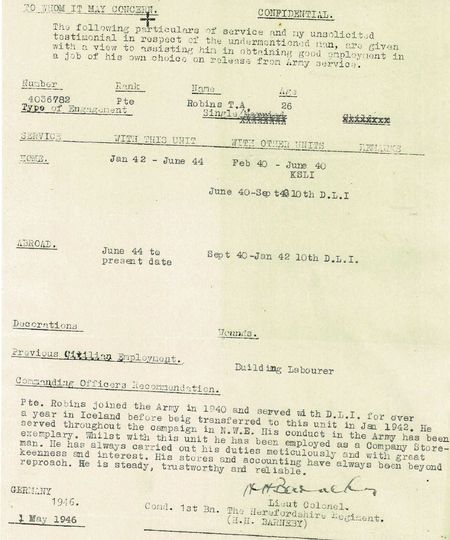
Monthly Feature
Medals and the Man
INDEX
Date Subject
Jan 26 824 Pte Charles Percy TAYLOR
Dec 25 2037/235567 CQMS WJ Rogers
Nov 25 Maj WAP Crofts
Oct 25 Ken Crockford
Sep 25 Faulkner - Father & Son
Aug 25 Reg Griffiths
Jul 25 The Defence Medal and The Home Guard
Jun 25 Pte Alf Welch
May 25 Maj Ernest Amphlett Capel MC TD
Apr 25 Ainslie - Father & Son
Mar 25 36th Regimental Medal
Feb 25 The Yeoman Brothers
Jan 25 Lt Col Gilbert Drage
Dec 24 Medal Mystery - Cpl AB Bassett
Nov 24 Pte EV Cale
Oct 24 Ken Steen
Sep 24 Pte CR Edwards
Aug 24 Capt AV Holman
Jul 24 Lt Col WF Chipp
Jun-24 Maj Colin Howe
May-24 Capt Fox-Russell VC
Apr-24 Sgt C Jones
Feb-24 CSM R Harman
Jan-24 Barnham & Baynham
Dec-23 Maj ALB Green DSO TD
Nov-23 Pte TA Robins
January 2026
824 Pte Charles Percy TAYLOR
Charles Percy Taylor was born in Ledbury in 1891; he was the only child of Charles and Hannah. In 1907 he left home and served as a steward/waiter on the North Atlantic sailing route (ran away to sea(?)). he served on the Lusitania and the Mauretania on trips to New York.
In 1908 he returned to Ledbury and was employed by Hopkins Coach Builder in new Street Ledbury. At this time he joined the Herefordshire Regiment as a bandsman playing the cornet.
He was mobilised on the outbreak of war in August 1914 and was accidentally shot in December 1914. The bandsmen became batmen and after a route march the batmen were cleaning their officers revolvers; one officer had loaded his revolver unknown to his batman who then accidentally discharged the weapon wounding Pte Taylor. He was the transferred from the 1st Battalion and as a result of his wound did not deploy with the Battalion to Suvla Bay.
His service during 1915/16/17 is not known, he was renumbered 235062 in 1917.
In 1918 he deployed to the Western Front and was attached to 1st Battalion Kings Shropshire Light Infantry and was taken Prisoner of War on 21 March 1918 during the German Spring Offensive. He was posted as 'missing presumed killed in action'. He was a PoW and sent a 'standard' postcard to his wife.
After the war he returned to Ledbury and worked as a painter/decorator; he raised a family and during the Second World War worked at the Rotherwas Ammunition factory in Hereford.
He died in Ledbury in 1954.
His medal entitlement is: British War Medal, Victory Medal, Territorial Force War Medal and Territorial Force Efficiency Medal all named 235062.
The TFWM was claimed by his Grandson in 1985.
There are 52 awards of the TFWM to The Herefords and only 9 groups comprising both the TFWM and the TFEM.



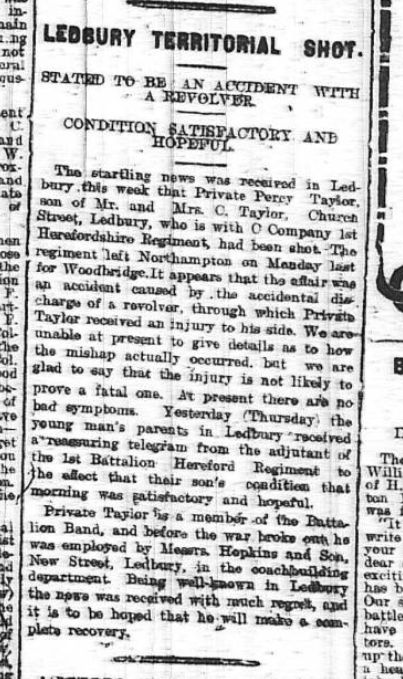
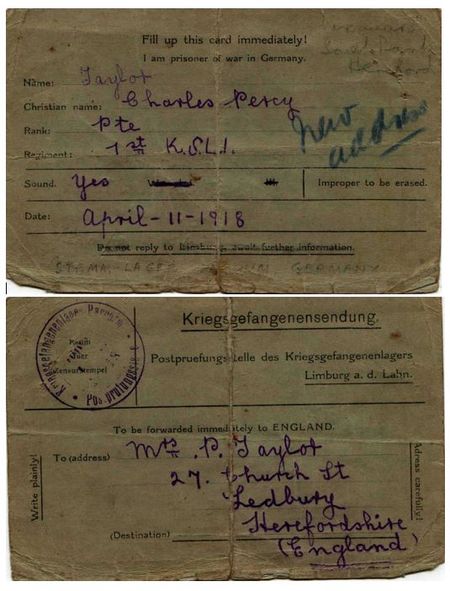


December 2025
2027/235567 CQMS William James ROGERS
Sjt Rogers from Hereford enlisted into The Herefordshire Regiment in September 1914, soon after the outbreak of the First World War. He was discharged in June 1919.
He served with The Herefords at Suvla Bay, in the Middle East and on the Western Front.
He was awarded the French Croix de Guerre in 1918.
His Croix de Guerre and certificates are held by the Museum.
November 2025
Maj WAP Crofts
This month's 'Man behind the Medal(s)' is Major William Alan Peter Crofts - known as Peter.
He was born in 1910 and Commissioned into the Herefordshire Regiment in 1936 - interestingly his Commissioning scroll is issued under the authority of the short reigned King Edward VIII.
He was mobilised in 1939 and served throughout the war with the Regiment, landing over the Normandy beaches in 1944 and taking part in the arrest of GAdml Doenitz at Flensberg in 1945.
He was awarded the Military Cross.
He led the Regiment's Freedom Parade in Hereford on 1945.
After the war he continued to serve with the Herefordshire Light Infantry and was awarded the Territorial Decoration with a further 2 service award bars.
He was the Manager of the 3 Counties Club located on Ayelstone Hill.









October 2025
Ken Crockford
Ken joined the 1st Battalion in Normandy shortly after D Day. He is quoted extensively in the monthly accounts published on the website WW2 Diaries.
Ken served with the Battalion until the end of the war. After the war he became a regular officer in the Royal Army Service Corps (RASC).
His medals comprise:
Military Cross, 39/45 Star, France & Germany Star, Defence Medal, War medal, General Service Medal 1918-62 with bar 'Canal Zone' (authorised and issued 2003), General Service Medal 1962-2007 with bar 'Borneo', Chevalier of the Order of Leopold (Belgium), Croix de Guerre (Belgium), Pingyat Jasa Malaysia (authorised and issued 2004).
August 2025
1610 William Reginald Griffiths (Reg)
Reg Griffiths was born and lived in Old Radnor, the son of the Station Master. He worked in the offices of the Old Radnor Trading Company.
He was one of the first of many to volunteer for service with The Herefordshire Regiment on the outbreak of war in August 1914. Together with a couple of pals they cycled to Hereford to enlist, had their names taken and were sent home to wait for the call!
He was called up and remembered drilling in civilian clothes before being issued with uniform and training with the 1st Battalion in the Newmarket area.
He served with the Battalion at Suvla Bay as a signaller and was wounded by a bullet in the foot and was evacuated to England, He recovered and went through the reinforcement process with the 2nd Battalion before rejoining the 1st Battalion in Egypt. He later transferred to the Imperial Camel Corps and then to the Royal Flying Corps which became the Royal Air Force. His service in the First World War saw him awarded the 1914/15 Star (named Herefordshire Regiment), British War (named RAF) and Victory (named RAF) Medals.
After the War he took Holy Orders and became a vicar and during the Second World War rejoined the forces serving as a Regimental Padre in Northern Ireland. His war service was rewarded with the Defence and War Medals.
Following the Second World War he served as the Regimental Padre of the Herefordshire Light Infantry and the Herefordshire Battalion of the Army Cadet Force. For this further service he was awarded the Territorial Decoration and second award bar and made a Member of the Order of The British Empire (Military Division) (MBE).
He was the vicar at Pixley in Hereford and retired to live in Hereford and was for many years the secretary of the 1914/19 Old Comrades Association.
He was the Deputy Provincial Grandmaster of the Herefordshire Freemasons.
Reg Died in 1989 at the age of 93.
July 2025
World War 2 Defence Medal and The Home Guard
This month's post explains the award of the World War 2 Defence Medal to members of the Home Guard.
Tens of thousands of men, and later women, joined the Home Guard to defend the UK and engage with the enemy in the case of invasion. The were organised on a military structure for local tasks which included, patrolling, checkpoints, key point defence and PoW escorts to name but a few.
Those that served in a recognised organisation for 3 years were eligible for the award of the Defence Medal. The organisations included the ARP, Fire Service, Police, Coast Guard, some Boy Scouts received the medal as they acted as runners for their local Home Guard unit.
The Home Guard were by far the unit with the largest number of eligible members.
The Medal was issued unnamed.
The ribbon colours represented - the Green and Pleasant land (of Britain), the black of the blackout and the red for the fire of the blitz.
At standdown in December 1944 the Herefordshire Home Guard was over 7,000 strong. It is not clear how many of these would have qualified for the Defence Medal. Additionally 'mixed' service gained from Home Guard (or other service time) could be added to qualification time after 'call up'.
June 2025
4104966 Pte Alf Welch
This month we tell the story of 4104966 Private Alfred Welch. He was born in London in 1916 but became a Barnardo boy. He went to work on farms in Wales and came to Hereford to work in the munitions factory at Rotherwas. He lodged with the Daly family at 31 Union St. Hereford.
He enlisted into the Herefordshire Regiment on 9 March 1938 and served with A Company.
He was at camp and mobilized with the 1st Battalion on the outbreak of the Second World War in September 1939. He transferred to the 9 Battalion King's Own Royal Regiment (9KORR) in February 1940 he said that he volunteered for the transfer as he was on an anti tank course and was struggling with degrees and angles. He also said that firing the Boy's anti tank rifle nearly broke his shoulder.
9KORR deployed to France/Belgium as part of the British Expeditionary Force during the period of the phony war. Once the German blitzkrieg started they retired towards Dunkirk. Alf remembered the long marches with nothing to drink. It was during this retirement, on 28th May that he recalled he was sitting on the ground and the next second he was in the same position but upside down he'd been hit in the leg just above the knee and was put in an ambulance with some other wounded including an officer and a Sergeant. They were constantly harassed by German aircraft.
It was decreed that wounded should not enter the Dunkirk area, and Alf with others were left in a school and a Church which had been established as a Casualty Clearing Station. They were then made Prisoners of War on 30 May. From here he was moved to a hospital in Ghent, some PoWs escaped from here but their fate is not known; Alf could not go with them as he could not walk.
Alf went through several PoW camps and ended up in Stalag XXB in Poland, where he ‘went out’ to work on farms. They didn’t particularly think of escape as their main pre occupation was with getting enough food.
As a PoW Alf received letters from the Daly’s and also his old pal (from Barnardo and Herefordshire days) Frank Castle – including a photographs of his Herefordshire Regiment pals – stamped on the reverse by a German censor’s stamp.
In early 1945 Germany started moving PoWs westwards as a result of the Russian advances in the East. The marches went on for weeks in appalling winter weather, food and shelter were scarce and there were many casualties.
One morning, after sleeping in a farm, they woke to find their German guards gone. Fighting was still going on all about them when they spotted, what they thought were German tanks – they turned out to be American which they greeted enthusiastically. They were told to keep walking Westwards to meet the main Allied Forces. This was quite an ad hoc journey with stories of commandeering a farm tractor and trailer and even ‘borrowing’ an American truck – along the route ‘scrounging’ food and drink from American units and canteens.
Exactly how he rejoined the British Army and got back to UK is not known, he was at a unit in Chilwell in and worked in the MT until he was discharged in December 1945.
While at Chilwell he met and married a local girl who was working in the NAAFI.
Alf’s medal entitlement was the 1939/45 Star and the War Medal – as PoW he did not qualify for the Defence Medal, and those that served at Dunkirk did not receive the France and Germany Star. The town of Dunkirk issued a Dunkirk Commemorative Medal in 1960 although not an official medal it was worn by many Dunkirk men as a semi official medal), but this was designed for those who took part in Operation Dynamo and those that were ‘lifted’ off the beaches – again Alf did not qualify.
He always felt aggrieved at his medal entitlement, but in 2010 his full TA service was recognized and he was awarded the Efficiency Medal (Territorial). The qualification for this medal is 12 years so Alf thought he did not qualify but he did not realise that war service counted double – so he did qualify.






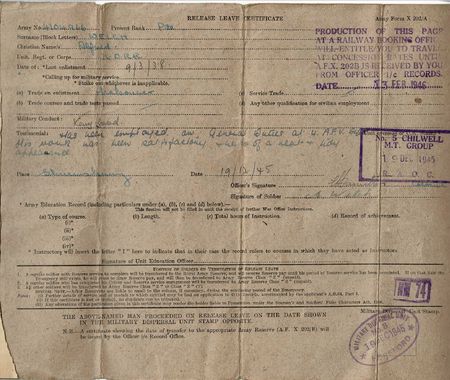


May 2025
Major Ernest Amphlett Capel MC TD
Ernest Amplett Capel was born and died in Hereford. He was solicitor, City Coroner and held many other civic and community appointments.
He joined the Herefordshire Rifle Volunteers in 1904 and served with the Herefordshire Regiment throughout the First World War. He was wounded at Suvla Bay and on recovery rejoined the Battalion in Egypt. He commanded a Company at Post 6 during the Battle of Romani - this was the Turks last attempt to invade Egypt and Post 6 was the forward outpost; he was awarded the Military Cross for this action.
He was also Mentioned in Despatches.
He joined the Home Guard at ins formation in World War 2, until he had to resign on age grounds in 1942.
He died in December 1955.






April 2025
Ainslie - Father & Son
This month's feature is a father and sone group donated tot he Museum by the daughter in law/wife.
Williams Ainslie had served with the Herefordshire Rifle Volunteers and was a founding member of the Herefordshire Regiment on its formation in 1908. He was born in Scotland in 1877 and trained at Aberdeen University where he qualified as a doctor in 1897. He had served as a corporal in the Volunteer Medical Staff Corps whilst at university (1893-97). He was Commissioned into the Royal Army Medical Corps on 14 September 1914 and served at home before going overseas to France on 14 December 1914. He was awarded the Military Cross announced in the London Gazette in January 1917.
He first lived in Kington before moving to and practicing in Hereford
He held many appointments in the county including Chief Steward of Hereford, consultant surgeon to several Herefordshire hospitals and chairman of Hereford Football Club. His wife Janet was Mayor of Hereford in 1955. He died in 1959.
His son William Ronald was born in Hereford in 1914. little is known of his early years and his name next appears in the Indian Army List on 9 August 1944, where he is granted and Emergency Commission as a Second Lieutenant from the rank of sergeant. The London Gazette of October 1945 records that he is granted a War Substantive Commission in the rank of Lieutenant in the Intelligence Corps from the War Substantive Indian List.
He nest appears in the London Gazette when he is granted a Commission in the Hertfordshire Army Cadet Force (yes Hertfordshire!), being awarded the Cadet Forces Medal in March 1964. At some stage he moved to Herefordshire and resigned his Commission with the Herefordshire ACF in March 1975; he died in Hereford in 1982.
March 2025
36th Regimental Medal
This month's feature is about a medal that was perhaps never issued!
The medal in question is a privately made medal to the 36th Foof. The medal was acquired by the museum from the collection of the late Wing Commander John Barker, a collector to and a researcher of the Worcestershire Regiment. The 36th of Foot was prior to the 1880 Army reforms termed 'Herefordshire'. In 1880 it became the 2nd Battalion The Worcestershire Regiment hence John's interest and ours.
John carried out extensive research into the medal. He discovered an identical medal disc in the collection of the Worcestershire Regimental Museum; it is on display together with the recipient's Military General Service (MGS) medal with 7 clasps.
Both medals comprise a silver disc engraved on the back with '36 FIRM' and sunbursting from the centre the names of Peninsula War engagements: VIMIERA, CORUNNA, BARBA DEL PORTO, SALAMANCA, PYRENEES, NIVELLE, NIVE, ORTHES, TOULOUSE.
On the front the personal dedication:
Presented by his Br(other) N(on) C(ommissined) Off(ice)rs of the Depot as a token of his long service of 30 years.
On the front of the suspender:
36th Regt FIRM [Firm being the motto of the 36th]
The rear of the Worcestershire Museum medal bears the inscription:
C(o)l(our) Serg(ent) Sam(ua)l Richardson.
The Herefordshire Museum medal is unnamed.
John then carried out extensive research to try and identify the recipient of the unnamed medal. The first task was to compare the 7 clasps on Richardson’s MGS with the 9 ‘engagements’ listed on the medal. Pyrenees and Barba Del Porto account for the difference. Pyrenees is a Battle Honour named on the Regimental Colour and men of the 36th were awarded this clasp – the reason Richardson does not have this cannot be determined [see note at end of article]. The Historical Record of the 36th Foot records that half of the Battalion took part in an action at the Barbo Del Porto on 11 May 1809, but this action was not authorised as a clasp to the MGS; it is assumed Richardson was one of the men of the Battalion which took part in the action.
A detailed comparison of the 2 medal discs shows some minor differences – but these can probably be accounted for by them being hand engraved and the 2 discs are for all intents and purposes identical. The condition of the unnamed medal was noted to be better than the named one, which would perhaps indicate that it had never been worn. This examination also indicated that the suspender of the unnamed medal had never been named.
John carried out extensive research to identify a long serving soldier of the 36th who had a similar career to Richardson – his research drew a blank. There were long serving NCOs but none with 30 years service or in receipt of the MGS with clasps matching the medal or Richardson’s MGS Clasps.
The mystery of the second medal deepened and led to speculation and possible solutions:
- the second medal was a replacement for an unsatisfactory one - but detailed examination does not support this.
- the suspender was defective, but if this was the case surely just a new suspender would have been made.
John’s conclusion was that the most likely solution was that the manufacturer set 2 craftsmen (or apprentices) on the task and then selected the ‘best’ medal to have named.
John Barker was a great friend to The Worcestershire Regimental Museum and also to The
Herefordshire Regimental Museum, the quality of his research was excellent and we are delighted to be able to show that in this article.
The photographs of Richardson’s medal are reproduced by kind permission of © Trustees of the
Mercian Regiment Museum (Worcestershire).
The Military General Service Medal 1793-1814
The MGS is a subject worthy of an article in its own right! It was authorised in 1847 and issued in 1848, 34 years after the last battle it commemorated! Medals had to be applied for and it is likely that at the time distance between the actions and the application there were omissions – perhaps this is the case with Richardson’s MGS clasp entitlement.
29 bars were authorised for the Peninsula, Egypt, East & West Indies and the USA; the most authorised to one individual is 15.
February 2025
The Yeoman Brothers
This month we feature 2 brothers both of whom were killed.
The Yeoman brothers were born in Weston Beggard, Herefordshire of farming stock. They attended Hereford Cathedral School.
Lieutenant William Joseph George Yeomans was 20 when he was killed on 9 April 1017 on the Western Front; his obituary in the school old boys journal records:
Sec. Lieut. Walter Joseph George Yeomans, K.S.L I., was killed in action in France on April 9th, 1917. He was the younger son of Mr. and Mrs. J. H. Yeomans of Withington, and grandson of the late Henry Haywood of Blakemere House, Hereford. On the outbreak of war he left School and obtained a commission in November, 1914, being sent to the Staff College at Camberley. In August, 1916, he was wounded in Delville Wood. He rejoined his regiment on January 22nd, 1917, and was killed on Easter Monday, a fortnight before his 21st birthday.
Captain Haywood William Yeomans was 25 when he was killed on 8 October 1917, he was a keen sportsman and won many prizes at school. After school he went to Oxford The final record of Yeomans in Oxford is in the Oxford University Roll of Service, edited by E.S. Craig, Assistant Registrar of the University, and W.M. Gibson, (Oxford, Clarendon Press 1920). It gives his year of matriculation as 1911 and simply reads:
1911 Yeomans, H. W. (Sept. 1, 1914). Capt. 1st Herefordshire Regt., attd. M.G.C. France. Killed in action at Onde Kenescik, nr. Gheluvelt, on Oct. 8, 1917.*
Both brothers served at varying times with the Herefordshire Regiment.
They were the only sons and their medals are the ‘simple’ British War Medal and Victory Medal; their
family also received the Memorial Plaque.
A seemingly small momento of 2 gallant young men.
They are commemorated on the Withington War Memorial.
January 2025
Lt Col Gilbert Drage
Lt Col Gilbert Drage was Commanding Officer of the 1st Battalion from 1914 to 1918 and saw service with the Battalion in the UK, Gallipoli and The Middle East.
Col Drage had served for 23 years in the Royal Marines, retiring as a Major in 1913 when he joined the Herefordshire Regiment as a Major. He was promoted and appointed the Commanding Officer on the outbreak of war in 1914.
He oversaw the integration of huge numbers of recruits in Autumn 1914, organising their individual training and also that of the Battalion as a unit. He led the Battalion when it landed at Suvla Bay and was injured in the first advance - but returned to duty. He oversaw the reconstitution of the Battalion in Egypt in 1916, took part in the Western Defences and then the Suez Defences before advancing across the Sinai and taking part in the Gaza battles and the advance to Jerusalem.
He earned no medals during his service wit the Royal Marines but whilst with the Herefords was awarded the following awards and medals; Distinguished Service Order (DSO) (1/1/1917), 1914/15 Star, British War Medal, Victory Medal with Mention in Despatches emblem (13/7/1916, 1/12/1916, 14/6/1918) and the Order of The Nile (3rd Class) (9/11/1918).
His medals are held in the Regimental Museum.
His obituary from the Radnor Society Journal says a little more about him and shows his wide interests:
We have to record with deep regret the death on 8th May, 1952, of Lt. Col. Gilbert Drage, D.S.O., who had been a member of the Society since 1935, and was for many years a member of the Executive Committee. He was 81, but was active to the end. His fine presence and soldierly bearing, and his courteous manner, will be an enduring memory for all who knew him. Colonel Drage had a distinguished career, first as an officer in the Royal Marines for 23 years, and afterwards, in the first World War, commanding the 1st Battalion of the Herefordshire Regiment in Gallipoli, Egypt, and Palestine. He was made a Justice of the Peace for Radnorshire in 1925, and a Deputy Lieutenant in 1938. His book Gazpacho (reviewed in the Transactions of 1949) showed him as he really was, a man of culture, wide travel, and an almost unlimited variety of interest. The Society is indebted to him for several delightful contributions to the Transactions, on subjects so diverse as sundials, mill stones, and woodcock. In addition, his Notes on the Militia," published by the Society in 1937, will long be a standard work of reference, particularly in regard to the Royal Radnor Militia. Colonel Drage was pre-deceased by his wife, who shared to the full his interests, and amassed a large and valuable collection of books and works of art. When living at The Rodd, Presteigne, both he and Mrs. Drage became proficient in hand-loom weaving, on which subject he latterly published a small book, in an effort to bring back to the country side this rural handicraft. A radiant sundial placed on the wall of Norton church tower was one of his last efforts for the parish where he spent the evening of his days.
December 2024
Medal Mystery Cpl AB Bassett
Barry Lindfield presented a medal to The Herefordshire Light Infantry Museum with a mystery behind it! The medal had been found by Barry’s son David, buried at the roadside of the A49 main road just north of Leominster.
The medal is the Territorial Efficiency named to 4105427 Corporal AB Bassett of the Herefordshire Regiment. The Museum archives show that Cpl Arthur Brian Bassett, aged 23, a shop assistant of South Street Leominster joined The Herefordshire Regiment in May 1939. He was mobilised on the outbreak of war in September 1939 and served throughout the war rising to the rank of corporal - although details of his service are not known.
The Medal was awarded for 12 years service with the Territorials, with War Service counting double; Cpl Bassett received his medal in July 1946.
Do you know anything about Cpl Bassett or how the medal came to be lost?
November 2024
Pte EV Cale
4103028 Pte later Sergeant Edwin Victor CALE lived in Hereford and joined the Herefordshire Regiment on 8th October 1920.
He regularly attended camps and was awarded the Efficiency Medal at the 1934 Annual Camp.
He was mobilised for War Service in 1939 but discharged 'failing to fulfil Army fitness requirements'.
He was awarded the War Medal for completing 30 days service.
He had been part of the 'Procession Party' from the Regiment at the 1937 Coronation of King George VI in London.
October 2024
Ken Steen
Many Ledbury people will remember Dr Steen who had a practice in The Southend in Ledbury and lived at The Pyes Nest in Parkway in the 1950s/60s and 70s.
He was also a member of St John Ambulance in Herefordshire and the Regimental Medical Officer of 6 Battalion Light Infantry with units in Ross and Ledbury. He undertook full time service and also supported the Army Cadet Force.




September 2024
14825453 Pte CR Edwards
This month we show the full medal group to 14825453 Pte Charles Robert Edwards. At first glance this appears to be an incomplete group and that at least the 1939/45 star is missing - however this is his complete entitlement.
Pte Edwards was a late 'recruit' to the Army - he enlisted in August 1944 - probably conscripted and trained in a central infantry training unit and was allocated to a regiment on completion of training. This location would have been made on the basis of the Army's need and Pte Edwards, although from London was drafted to The Herefordshire Regiment.
He was posted to the 1st Battalion and joined them in North West Europe in February 1945 and completed 30 days service prior to the War's end in May, for which he qualified for the France and Germany Star Medal - his 30 days service also qualified hm for the War Medal. However the qualification period for the 1939/45 Star was 6 months in an operational theatre - which he did not achieve.
Therefore what appears to be an incomplete group is a complete group.
As a late ‘joiner’ his services were retained and he was not discharged until February 1948.
August 2024
Capt AV Holman
This month's featured man and medals are a bit of a mixture!
Capt Arthur Vincent Holman first served as a Private soldier with in the 'Volunteer Active Service Company 2nd Gloucestershire Regiment' and was entitled to the Queens South African Medal with the single bar 'South Africa 1901'.
He was Commissioned and served with the Herefordshire Regiment during the First World War, he was wounded at Suvla Bay and repatriated to England from the Middle East suffering from 'illness'. He died on 9 January 1917 in UK.
A newspaper account of his funeral is attached.
A group of related ephemera was donated to the museum in 1995 and includes:
a 3 bar QSA miniature medal
Capt Holman's British War Medal with the Queens South Africa Medal Ribbon.
Why he had a 3 bar QSA Miniature and what happened to his full size QSA and other First World War Medals (1914/15 Star and Victory Medals), and how the QSA ribbon became attached to his First World War Medal remains a mystery!
July 2024
Lt Col Wilkins Fitzwilliam Chipp DSO*, OBE, MC, ED
Lt Col Chipp, the most decorated Herefordshire Regiment soldier served in uniform from 1899 until 1956 and was awarded the Distinguished Service Order twice, the Military Cross, Mentioned in Despatches twice, Croix De Guerre from France and Belgium, Officer of the Order of The British Empire, Efficiency Decoration and Territorial Force Efficiency Medal in addition to First and Second World War campaign medals!
Chipp, the son of the Deputy Chief Constable for Herefordshire, had attended the Lady Hawkins school and, in 1899, at age 17 enlisted in the local company of The Herefordshire Rifle Volunteers at Kington.
Chipp's military career progressed, he was promoted Corporal in 1900, Sergeant in 1902 and Colour Sergeant in 1907. He was the Sergeant in charge of the Colour Party when Edward VII opened the Rhayader Dam and water works. On the formation of the Territorial Force in 1908 Chipp enlisted into the 1st Battalion of the newly formed Herefordshire Regiment. He received the King’s Colour on behalf of the Regiment at Windsor from King Edward VII in June 1909. He was also noted as a fine rifle shot.
In August 1915, Chipp landed with the Battalion at Suvla Bay Gallipoli. He wrote home of his comrades who were killed or wounded, of the cunning of 'Johny Turk', the shortages of water and the heat, flies and general misery. He took command of A Company when all the officers became casualties, over a period which included it being cut off for 5 days. He was wounded and hospitalised in Malta suffering from a bullet wound to the arm and bruising to the side. He recovered and rejoined the Battalion at Suvla, and was there when he was informed that he had been Commissioned on 9 October 1915. He was later evacuated through sickness to England before rejoining the Battalion in Egypt.
Chipp then served with the Battalion throughout its time in the Middle East; garrisoning outposts in Western Egypt and the Suez Canal, the battles of Romani, Gaza and Khuweilfeh, and the eventual relief of Jerusalem. He at various times was the Adjutant, company commander and for a time a staff officer on the staff of 158 Brigade. He was promoted captain and major, attended various staff courses, had a hill named after him in the high area of Tel Asur in Judea during the actions of Spring 1918. He was awarded the Military Cross for 'conspicuous gallantry and devotion to duty he carried out a valuable recce and cleared up an obscure situation. He readjusted parts of the line with great skill and showed complete disregard of danger' at Khuweilfeh in November 1917.
The Battalion sailed for France on 17 June 1918, ironically (as will be seen later) the convoy was escorted by Japanese destroyers. The great German offensive of the Spring was still not beaten and he had his first experience of the gas and slaughter of the Western Front in the Chateau Thierry area. By September the Battalion was in the Kemmel area and joined the great advance via Menin and Moen, being in reserve in the Wevelghem area on 11 Nov. During this period Chipp found himself as Company commander, Regimental Second in Command and for several periods Commanding Officer; he was always in the thick of the action and he was awarded the DSO for action in the Menin area in Oct 1918 when he ... 'commanded his Battalion with great skill and gallantry, with only part of his command he was ordered to take over the whole front and push on, an extremely difficult operation which he carried out at once under heavy shelling and machine gun and minenwerfer fire. It was entirely due to his own personal recce under fire and perfect control that enabled his men to overcome every obstacle'.
He was one of only two who received 'triple honours' (DSO and bar and MC) from King George V at Buckingham Palace in 1919.
The details of his inter war activities are not known in full, but his military service continued while he worked in the forestry service in India and Malaysia where he served in the Malay States Volunteer Regiment. He was made OBE in 1940.
He was a Wing Commander in the Admin and Special Duties Branch of the RAFVR at the time of the fall of Singapore in 1942, and was captured and endured over 3 years as a prisoner in Changi prison where he was appointed chief librarian. He was released and returned to England in 1946 aged 64. There is a handwritten account 'The Observer Corps, events leading up to the surrender of Singapore' which concludes 'despite the Jap searches the Observer Corps nominal roll was kept hidden and is still in the possession of the writer' signed W F Chipp Commanding. Chipp obviously had a penchant for hiding things. As illustrated by an account which he wrote and which was published in the KSLI and Herefordshire Regimental Journal, in brief:
'Having had some slight experience of the Japanese, and hearing first hand accounts of their behaviour since the invasion began, it was evident that any valuables in possession of prisoners, or abandoned would be quickly annexed .... I had in my possession my decorations and medals and was determined if possible to hide them from our captors........
For a secure hiding place I consulted ... the director of museums …. He suggested a safe hiding place could probably be found in the Raffles Museum ....... On the evening of the capitulation, 15 February 1942, we went to the museum........ The problem of finding a hiding place for my small case was solved by my friend who took me to the reptile room on the first floor. The larger models were mounted on hollow plaster casts, and in one of these I concealed my case.
Then 3 years and 7 months after the British surrender, came the capitulation of the Japanese on 3 September 1945 .... the Japanese guards were replaced by Ghurkas and no one was allowed to leave except by special permission .... On 6 September my old friend Colonel JP Read CBE (RA) came to the camp to enquire of his old acquaintances. I told him of the hidden case and a few days later received special permission to accompany him into Singapore, ..... the museum was locked, but we found an assistant, the same one that had admitted us 4 years previously, and entered the museum ..... the reptile room was found to be locked and all exhibits covered by sheeting. The assistant explained that the Japanese disliked reptiles and had kept the room locked during their occupation ... lifting up the hamadryad I quickly found my case with contents intact.....
A fascinating account, and perhaps one would think that Chipp had had enough of military service, but on return to UK he joined the reformed Home Guard as Lieutenant Colonel, commanding the 11 County Of London Battalion. His probable last appearance in uniform was on Armistice day 1956 when he commanded the Home Guard, Guard of Honour at the Grave on the Unknown Soldier in Westminster Abbey.
Chipp died in 1970 and there were many fond words in various obituaries that were published 'a truly great man who served others consistently throughout his life', 'as good a soldier that could be found', 'a truly great man has passed on'.
Lt Col Chipp's medals were purchased by the Museum in 2018.
June 2024
Major Colin John Malcolm Howe
Colin Howe was a native of Herefordshire and lived there most of his life. After war service he was a school teacher and Army Cadet Force Instructor in Bromyard.
He enlisted as a private soldier in the Herefordshire Regiment (4105444) in May 1939, aged 21 and was posted to the 2nd Battalion where he was promoted Colour Serjeant and employed as a Company Quarter Master Sergeant (CQMS).
He was (presumably on the disbandment of the 2nd Bn in June 1944) posted to the 4 Welch Regiment and served with them in North West Europe (NWE).
He related one amusing incident - whilst in NWE he went into the woods on a 'shovel recce'. Having settled down to do his business he looked around and about a 100 yards away saw a German soldier doing exactly the same thing - both soon finished their business waved at each other and disappeared back to their own lines. He would say that as an CQMS this was the closest he ever got to the enemy!
He became an instructor with Herefordshire Army Cadet Force and latterly commanded the Herefordshire (Light Infantry) Company within Hereford and Worcester ACF.
may 2024
Capt John Fox-Russell VC
The Victoria Cross in the highest gallantry award available under the British Honours system - It is awarded regardless of rank and ranks above any other Honour or Award. It was instituted in 1857 and to date some 1,358 have been awarded; the majority during the First World War.
No member of the Herefordshire Regiment has been awarded a VC but Captain John Fox-Russell was the Regimental Medical Officer of the 1/6th Battalion Royal Welch Fusiliers, part of 159 Brigade but attached to The Herefordshire Regiment when he won his Victoria Cross.
In the 3rd Battle of Gaza, November 1917 he was attached to the Herefordshire Regiment and it was during the action at Khuweilfeh he was awarded the VC for:
most conspicuous bravery displayed in action until he was killed. Captain Russell repeatedly went out to attend the wounded under murderous fire from snipers and machine-guns, and in many cases, when no other means were at hand, carried them in himself, although almost exhausted. He showed the greatest possible degree of valour.
An extract from the Battalion War Diary for the period records: About 1am the Battalion formed up in front of its bivouacs prior to moving forward the brigade place of assembly prior to attack. The Battalion, which should have been accompanied by a battalion of the Imperial Camel Corps, arrived at about 3.40am and took up its ordered formation of companies in platoon waves at 25 yard distances; each company having one platoon in the front line. Order of companies from right to left:
\ D – Capt Carver
\ C – Capt Evelyn
\ B – Capt Birnie
\ A – Capt Russell.
On the left of the brigade lines was 1/7 RWF, left of the Herefords were the 1/6 RWF by which the Battalion was to march. The Battalion had been ordered to take up a frontage of 500 yards, but owing to inaccuracies in the map and the necessity of getting astride the ridge leading up to the table topped mountain, it was found necessary to increase the frontage to well over 1,000 yards and this in spite of the fact that the Battalion of the Imperial Camel Corps had been diverted to operate on the right flank of the Battalion.
At 3.48am some of our guns fired which caused some slight misapprehension as it was thought that our artillery barraged was timed for 4am had commenced. At 4am the Battalion moved steadily forward, covered by a heavy artillery and machine gun barrage, but for some reason touch had not been made with the 1/6 RWF on our left. Owing to the configuration of the ground, the tendency of the Battalion was rather to converge on its left and it was not clear that D Coy actually moved over Table Top Hill, an impossible hill to hold. Some of the Herefords became mixed up with the Imperial Camel Corps who afterwards came up on the left flank. The Battalion pushed on and reached the reverse slope of Tel El Khuweilfeh, shooting and bayonetting many Turks on the way.
Here abouts 9 Turkish guns were captured and the transport of a machine gun company decimated. Unfortunately our artillery barrage opened up again and compelled the Herefords to abandon their captured guns. At this time there was driving mist making it impossible to distinguish friend from foe at more than a few hundred yards.
From the above cause and the very accurate shooting of the enemy guns and snipers the Battalion suffered rather heavy casualties, especially amongst the officers, 6 of whom were killed while gallantly leading the men and 5 were wounded. The Battalion maintained the position it had won until relieved by 1/5 RWF the next day.
During the course of the battle the Battalion took 5 officers and 39 soldier prisoner and 10 soldiers the next day.
On relief the Battalion moved to bivouac area in reach of brigade battle HQ.
Capt Fox-Russell’s wife, Alma whom he married in September 1916 was presented with his Victoria Cross by King George V at Buckingham Palace on 2 March 1918.
He had previously been awarded the Military Cross for his actions during the 1st Battle of Gaza and also mentioned in despatches. He was also awarded the Territorial Force War Medal and his medals are in The Royal Army Medical Corps collection.
John Fox-Russell had been born in Holyhead North Wales and attended Magdalen College, Cambridge and St Bees school in Cumbria before completing his medical training at The Middlesex Hospital. He was a member of the Officer training Corps and was mobilised in August 1914.
Two other old boys from St Bees also won Victoria Crosses - Captain Leefe Robinson, RFC and Captain Richard Wain, Tank Corps.
He is buried in the Beersheba Commonwealth War Graves Commission cemetery.
On the centenary of his award a paving stone was unveiled in Holyhead.

April 2024
142 Sgt C Jones
Sgt Jones full career is not known - what is known is that he was an employee of the Post Office and served with the Herefordshire Rifle Volunteers and the Herefordshire Regiment and with the Royal Engineers during the Boer War and First World War. The Royal Engineers were responsible for post and communications and it is probable that he was employed in that role.
He was clearly an outstanding individual being awarded the Meritorious Service Medal for military service and the Imperial Service Medal for his service with the Post Office.


February 2024
Sjt Maj R Harman
Sjt Maj Harman's group of medals in unique to the Regiment; his is the only award of the Serbian Gold Medal for Bravery. This was 'gazetted' in February 1917, unfortunately there is no citation other than 'For Services in The Middle East'. Probably for action in 1916 and possibly from the Battle of Romani in August.
He enlisted at Hereford in late 1914 and was given regimental number 1822.
He served with the Battalion at Suvla Bay, Gallipoli and then in the Middle East and the Western Front; he was renumbered 235451 and was discharged 29 January 1919.
He re-enlisted in July 1921 as 4103351 aged 24 and 5 months and attended every annual camp from 1921 until 1939. He took part in the 1935 Jubilee Parade and the Coronation parade in London and was accordingly awarded the 1935 Jubilee Medal. He was transferred to the Gloucestershire Provisional Battalion as unfit for overseas service and discharged as unfit for service in July 1941.
His Second World War service entitled him to the War Medal and it is for speculation whether he joined the Home Guard - if he did and served for 3 years he would have also been entitles to the Defence medal.
He died in 1966.




January 2024
Barnham and Baynham
This month we are featuring 2 medal groups which caused some confusion to the Regimental management team!
The 2 medal groups, which are almost the same, were donated to the Museum on successive days, but one group the Curator and the other to his assistant the other not knowing that there were 2 separate donations. Several days later they met and were discussing recent donations and both mentioned the donation they had received but each believed that the other was quoting the wrong surname and a ‘healthy’ discussion took place – eventually the fact that there were 2 similarly named and similar groups was established!
Both groups consist of the 39/45 Star, France & Germany Star, Defence, War and Efficiency Medal (Territorial) Medals; Baynham’s medal include a bar to the Efficiency Medal.
4105393 Pte Cyril Baynham lived at The Callow and enlisted into the Herefordshire Regiment at Hereford 1 May 1939 aged 18 years and one month. He transferred to the Royal Welsh Fusiliers where he was awarded the Efficiency Medal; He later served in the MT Section of the Herefordshire Light Infantry where he was awarded the Bar to the medal.
4105136 Pte Harry Barnham lived in Westfields, Hereford and enlisted into the Herefordshire Regiment at Hereford 20 March 1939 aged 29 and 3 months. He was promoted corporal and served in the Carrier Platoon.
December 2023
Maj ALB Green DSO TD
Major Arthur Llewellyn Baldwin Green was a medical doctor practicing in Ross On Wye but he served in the Herefordshire Regiment during The First World War as an infantry officer and was a Company Commander. He had previously served with The Herefordshire Rifle Volunteers.
He sailed with the Battalion for Suvla Bay on board the Euripides.
He was awarded the Distinguished Service Order (DSO) for services in the Middle East in 1917 and was also mentioned in Despatches in July 1917 and January 1918. He was awarded the Territorial Decoration (TD) in May 1919. He was also awarded the 1953 Coronation Medal for services to The British Legion.
He was severely wounded at Suvla Bay and one resident of Ross On Wye, who was a patient of 'Dr' Green said - I was 4 years old and he was our family doctor, in practice at Ross until he retired. A lovely man, and although one knew he had been badly wounded, I doubt whether anyone had ever heard of his DSO. Very modest and unassuming, and much loved by his patients.
His medals are held in the Regimental Museum as is a watch he was wearing which was hit by a Turkish bullet and possibly saved his life.
November 2023
4036782 Private TA Robins
Charles Percy Taylor was born in Ledbury in 1891; he was the only child of Charles and Hannah. In 1907 he left home and served as a steward/waiter on the North Atlantic sailing route (ran away to sea(?)). he served on the Lusitania and the Mauretania on trips to New York.
In 1908 he returned to Ledbury and was employed by Hopkins Coach Builder in new Street Ledbury. At this time he joined the Herefordshire Regiment as a bandsman playing the cornet.
He was mobilised on the outbreak of war in August 1914 and was accidentally shot in December 1914. The bandsmen became batmen and after a route march the batmen were cleaning their officers revolvers; one officer had loaded his revolver unknown to his batman who then accidentally discharged the weapon wounding Pte Taylor. He was the transferred from the 1st Battalion and as a result of his wound did not deploy with the Battalion to Suvla Bay.
His service during 1915/16/17 is not known, he was renumbered 235062 in 1917.
In 1918 he deployed to the Western Front and was attached to 1st Battalion Kings Shropshire Light Infantry and was taken Prisoner of War on 21 March 1918 during the German Spring Offensive. He was posted as 'missing presumed killed in action'. He was a PoW and sent a 'standard' postcard to his wife.
After the war he returned to Ledbury and worked as a painter/decorator; he raised a family and during the Second World War worked at the Rotherwas Ammunition factory in Hereford.
He died in Ledbury in 1954.
His medal entitlement is: British War Medal, Victory Medal, Territorial Force War Medal and Territorial Force Efficiency Medal all named 235062.
The TFWM was claimed by his Grandson in 1985.
There are 52 awards of the TFWM to The Herefords and only 9 groups comprising both the TFWM and the TFEM.
